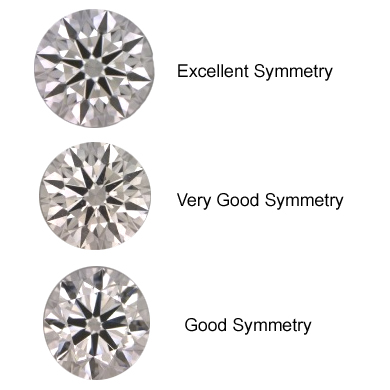During diamond grading, many aspects of the stone are examined. The size of the table in relation to the girdle perimeter is considered as are the angles of the upper and lower halves of the jewel. How the diamond takes in and reflects light is also taken into account. While it’s listed as a grade separate from cut, symmetry too carefully considered.
For a diamond to achieve its best brilliance, it should be cut just so. A stone that is overly deep or shallow will have light leak through the sides rather than reflect back to the viewer’s eye. Before the internal light can be viewed, it should travel throughout the interior of the crystal, brightening the jewel. A symmetrical cut allows for even light return throughout the stone.
Some diamond cuts may only have lines of symmetry in specific directions. Fancy cuts such as pear diamonds, marquise cut diamonds or heart shape diamonds fall under this category. The limited symmetry can lead to distinct patches of shadow within the center of the jewel, known as the bow tie effect. While cutters try to minimize its visibility, bow ties are still a possibility.
Round cut diamonds have more lines of symmetry than fancy outlines like hearts. They also have stricter guidelines as to how they should be cut, which in turn influences how their regularity is viewed. Quirks in the jewel’s symmetry may throw off carefully planned faceting, resulting in less than ideal brilliance. If the rough is oddly shaped, cutter must try to find a compromise between optimal brilliance and following the rough outlines to preserve carat.
When evaluating symmetry, gemologists look for uneven outlines, off-center tables and other details. With round brilliant cut diamonds, they don’t mentally divide the stone in half, but cut the jewel into eighths. Each segment is compared to the others and their similarities and differences catalogued. The stone then receives a grade which can range from Poor to Excellent.






